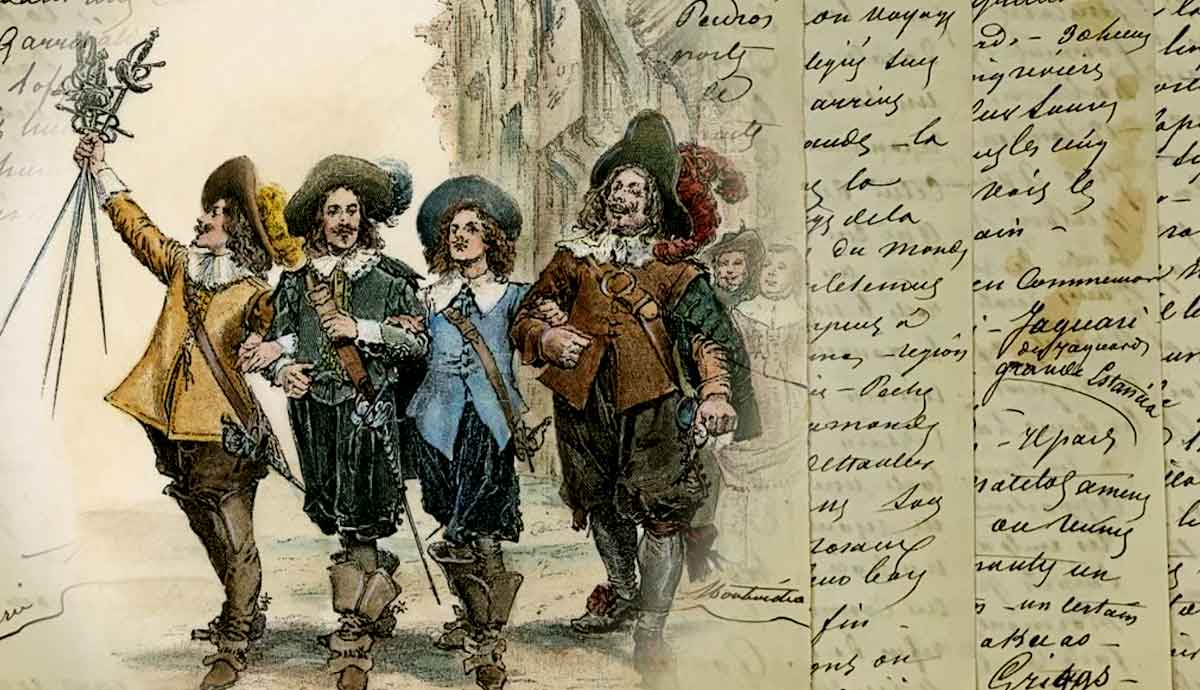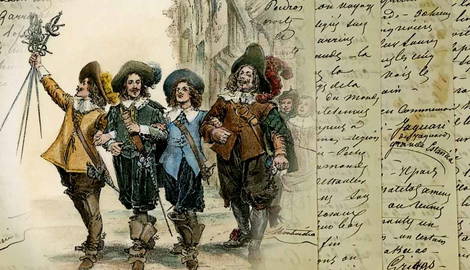
After planning on pursuing a legal career following his father’s untimely death, Alexandre Dumas would go on to become one of France’s most enduringly popular authors. Though he began his literary career writing melodramatic plays, he soon turned his attention to writing novels – a pursuit he suspected would prove more lucrative. And, with the runaway success of such novels as The Count of Monte Cristo and The Three Musketeers, his suspicions were proved right. He earned a fortune through his flair for storytelling and his prodigious output of work, but he also lived a lavish lifestyle and, as a consequence, was frequently insolvent. Here, we look at just five of his novels, including his two most famous works, drawing out his lasting preoccupation with such themes as faith, love, desire, and injustice.
1. Georges (1843)

In 1843, Dumas published the novella Georges, set on the Isle de France (today Mauritius). The novella is heavily concerned with questions of race, racism, and slavery, all of which were of major concern for Dumas as a man of mixed race and the grandson of Marie-Cessette Dumas, an enslaved woman of Afro-Caribbean heritage. These are also themes that Dumas explored in his earlier work Captain Pamphile, an 1839 children’s novel of strongly anti-slavery sentiment.
The eponymous protagonist, Georges, is a mixed-race man who can “pass” as white. However, the white planters on the island spurn him. Even when British forces attempt to invade the island, the white planters will not allow him to fight alongside them. Instead, he forms a Black militia group that successfully routs the invading British column, though the white planters refuse to acknowledge the bravery of Georges and his troops.
Tensions between Georges and the white island inhabitants are high. When a fight breaks out between Georges and Henri Malmédie, the son of a rich planter, Georges’ father sends both him and his brother Jacques to France to be educated. Here, he is met with and overcomes various challenges to become part of Parisian high society.
When he returns to the island, the planters fail to recognize him, and he quickly finds favor within the white society there. But when his conscience compels him to lead the island’s enslaved population in a revolt against the white slave owners, he jeopardizes not only his newfound social standing but his very existence.
2. The Corsican Brothers (1844)

First published in 1844, The Corsican Brothers is a novella that details the lives of two conjoined twin brothers. Though successfully separated at birth, the two continue to experience something of a symbiotic relationship and can feel each other’s emotional and physical pain.
The novella begins in 1841. Traveling to Corsica, the story’s narrator lodges in the house of Savilia de Franchi, a widow and the mother of the (formerly) conjoined twins, Lucien and Louis. Louis has moved to Paris to pursue a legal career (just as Dumas himself had done in his youth), while Lucien remains at home in Corsica with their mother.
Lucien, however, is not resting on his laurels while he stays behind with his aging mother. He informs the narrator that he – reluctantly – has a job to do: to act as mediator between the Orlandi and Colona families. In the course of doing so, the bond between the two brothers will be tested like never before.
Though it is perhaps the least famous of the three 1844 works by Dumas listed here, The Corsican Brothers has inspired numerous adaptations for stage and screen, beginning with the 1852 play of the same name by Dion Boucicault. With the advent of cinema in the early twentieth century, the novella was twice adapted as a silent film in 1917 and 1921 before Douglas Fairbanks Jr. took up the role of both twins in 1941.
Moreover, the story of The Corsican Brothers has been adapted in foreign language films, from the Tamil Apoorva Sagodharargal of 1949 and Neerum Neruppum of 1971 to Argentinian and French-Italian adaptations of 1955 and 1961, respectively. More recently, it was used as the inspiration for the 1988 film Big Business, starring Bette Middler and Lily Tomlin, and Jackie Chan’s 1992 action-comedy film Twin Dragons.
3. The Three Musketeers (1844)

Written in the style of a swashbuckler and set between 1625 and 1628, The Three Musketeers is a historical adventure novel first published in 1844. It is, however, a novel that also speaks directly to the politics of its time of publication. By setting the novel during Ancien Régime, Dumas points out the injustices and abuses of power that were rife at the time and so adds to contemporary debates in France between republicans and monarchists. Moreover, the novel was published serially from March to July 1844, meaning that its publication latterly coincided with the July Monarchy.
The novel details the exploits of D’Artagnan, a young man who leaves Gascony at the beginning of the novel to travel to Paris, where he hopes to join the Musketeers of the Guard. However, he is refused admittance to this elite group and is mocked by the Comte de Rochefort, an agent of Cardinal Richelieu.
Hoping to confront Rochefort, he inadvertently offends three musketeers named Athos, Porthos, and Aramis, with all of whom D’Artagnan must now fight a duel. When Cardinal Richelieu intends to have all four men arrested for illegal dueling, however, the four become allies. During the fight, D’Artagnan wounds Jussac, an officer of the Cardinal and a revered fighter. King Louis XIII then recruits D’Artagnan to the King’s Guards.
Not only does D’Artagnan forge a lasting bond with the three musketeers, but he also falls in love with his landlord’s wife, Constance Bonacieux. Constance, who has only just returned after being kidnapped, is in the service of Queen Anne, who is having an affair with the Duke of Buckingham. D’Artagnan must therefore fight not only to protect Constance’s honor but the Queen’s as well – with the help of the three musketeers along the way.
4. The Count of Monte Cristo (1844-46)

Set over a period stretching from 1815 to 1839, The Count of Monte Cristo reflects the political turmoil of France’s recent history through the fortunes of its heroic protagonist. On the very same day in 1815 that Napoleon flees the Island of Elba, the Pharaon ship docks in the harbor at Marseille. The captain of the ship, Leclère, has died during the voyage and, while dying, exhorted Edmond Dantès to deliver a package to General Bertrand (who is in exile with Napoleon) and relay a letter from Elba to Paris.
The Pharaon’s owner, Morrel, plans to appoint Dantès the ship’s new captain. Dantès’ colleague Danglars, however, envies Dantès’ promotion and worries about what this will mean for his own career. Danglars conspires with Fernand Mondego (the cousin of Dantès’ fiancée Mercédès, whom he wishes to wed) to falsely accuse Dantès of being a traitor and a loyalist to Bonaparte on the eve of his wedding. The next day, Dantès is arrested.
Dantès then spends six years in solitary confinement in the Château d’If before meeting the Abbé Faria, a priest and scholar. Faria tutors Dantès and informs him of the exact location of a treasure hoard on the Island of Monte Cristo.
Faria dies, and Dantès takes the corpse to Faria’s cell but places himself in the burial sack, armed with a knife. When he is thrown into the sea, he cuts through the sack and swims to the nearby Island of Tiboulen. Here, he is rescued by the Jeune-Amélie, a Genoese smuggling ship. He joins the ship’s crew for a few months before resolving to find the treasure. With his newfound fortune, he purchases the Island and the title of Count before setting about claiming vengeance. But will vengeance ultimately satisfy him? And is vengeance ours to seek?
5. The Black Tulip (1850)

Inspired by the Romantic movement, The Black Tulip was first published in 1850 while Dumas was in voluntary exile. Like The Count of Monte Cristo before it, The Black Tulip explores such themes as love, desire, and revenge.
Set in the Netherlands in 1672 during the so-called Tulip mania, the novel opens with the lynching of the brothers Johan and Cornelis de Witt for their rebellion against William of Orange. Meanwhile, the protagonist, Cornelius Van Baerle – the godson of Cornelius de Witt – resolves to grow a black tulip and win the 100,000 Francs promised by the city of Haarlem to whoever can pull off such a feat. However, his neighbor and fellow horticulturalist, Isaac Boxtel, is spying on him all the while. Growing wary of Cornelius’ possible success, he uses Cornelius’ connection to the de Witt brothers against him, and Cornelius is soon arrested and sentenced to life imprisonment.
Even behind bars, however, all is not lost for Cornelius. Here, he meets Rosa Gryphus, the daughter of his jailer. He confides in Rosa that he still retains the tulip bulbs he believes will grow into black tulips. With Rosa’s help – and what Dumas refers to as “Providence” – will Cornelius be able to save himself and win his fortune?

Alexandre Dumas made his name – and his fortune – as a novelist. The popularity of his work endures to this day. However, this popularity has also been interpreted by Dumas’ detractors as a mark of his novels’ lowbrow populism. Despite the attempts made over the years to disparage his work, however, Dumas’ gift for storytelling means that his work continues to have enduring appeal for readers. And, given the recent attempts to rehabilitate his reputation as a serious writer, it seems that this appeal will endure for many years to come.










